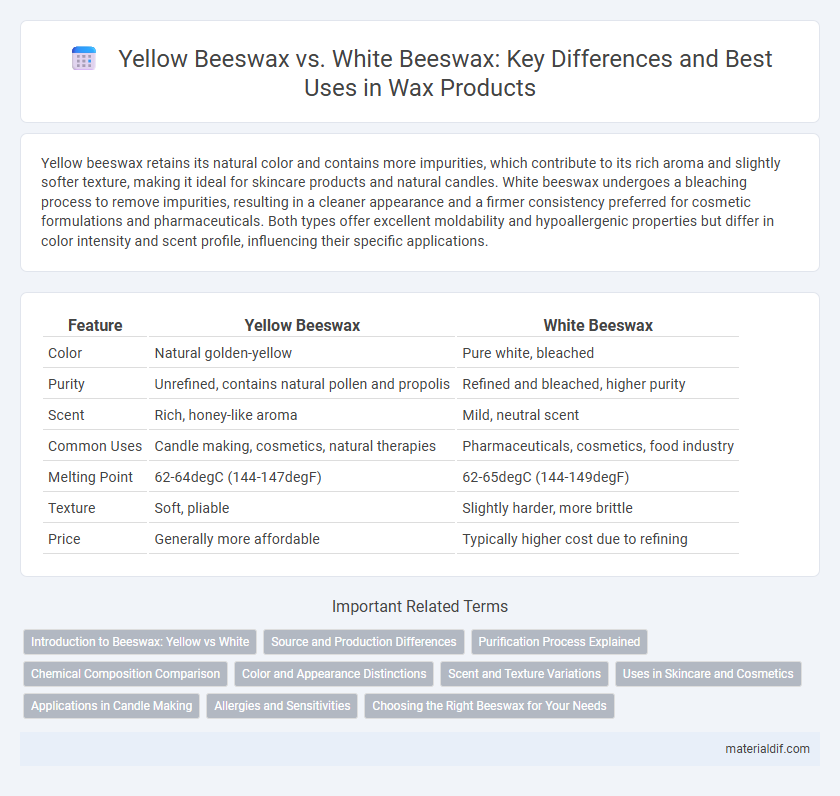Yellow beeswax retains its natural color and contains more impurities, which contribute to its rich aroma and slightly softer texture, making it ideal for skincare products and natural candles. White beeswax undergoes a bleaching process to remove impurities, resulting in a cleaner appearance and a firmer consistency preferred for cosmetic formulations and pharmaceuticals. Both types offer excellent moldability and hypoallergenic properties but differ in color intensity and scent profile, influencing their specific applications.
Table of Comparison
| Feature | Yellow Beeswax | White Beeswax |
|---|---|---|
| Color | Natural golden-yellow | Pure white, bleached |
| Purity | Unrefined, contains natural pollen and propolis | Refined and bleached, higher purity |
| Scent | Rich, honey-like aroma | Mild, neutral scent |
| Common Uses | Candle making, cosmetics, natural therapies | Pharmaceuticals, cosmetics, food industry |
| Melting Point | 62-64degC (144-147degF) | 62-65degC (144-149degF) |
| Texture | Soft, pliable | Slightly harder, more brittle |
| Price | Generally more affordable | Typically higher cost due to refining |
Introduction to Beeswax: Yellow vs White
Yellow beeswax contains natural pollen, propolis, and trace elements, giving it a richer color and aroma, which is ideal for natural skincare and candle-making. White beeswax undergoes bleaching or filtration to remove impurities and color, resulting in a neutral, odorless product preferred in cosmetic and pharmaceutical applications. Both types retain the core beeswax properties such as moisture retention, moldability, and a high melting point, but their differing purity levels influence their specific uses.
Source and Production Differences
Yellow beeswax originates directly from honeycomb, retaining natural pigments from pollen and propolis, which gives it its characteristic golden hue. White beeswax undergoes a refining process involving bleaching and filtering to remove impurities and color, resulting in a pure, pale wax. The source remains the same for both types--honeybee secretions--but the distinction lies in post-harvest processing methods.
Purification Process Explained
Yellow beeswax undergoes minimal processing, retaining natural impurities such as pollen and propolis that contribute to its characteristic color and aroma. White beeswax is produced through a refined purification process involving repeated filtering, bleaching, and deodorizing to remove impurities and color pigments, resulting in a pure, almost colorless product. This extensive purification affects the wax's texture and melting point, making white beeswax suitable for cosmetics and pharmaceuticals, whereas yellow beeswax is preferred for crafts and natural products.
Chemical Composition Comparison
Yellow beeswax contains higher amounts of natural pigments such as carotenoids, giving it its characteristic color, while white beeswax is bleached to remove these pigments. Chemically, both types primarily consist of esters of fatty acids and long-chain alcohols, but yellow beeswax retains more hydrocarbons and free acids compared to white beeswax. The bleaching process in white beeswax slightly alters the chemical composition, reducing the presence of minor organic compounds and impurities found in yellow beeswax.
Color and Appearance Distinctions
Yellow beeswax, naturally colored by pollen and propolis, displays a rich, golden hue with subtle variations that reflect its raw, unprocessed origin. White beeswax undergoes bleaching treatments to remove impurities and pigments, resulting in a clean, creamy-white appearance ideal for cosmetic and pharmaceutical applications. The color distinction directly impacts aesthetic choices in product formulation while maintaining identical chemical properties between the two types.
Scent and Texture Variations
Yellow beeswax has a natural, honey-like scent due to the pollen and propolis residues, while white beeswax is almost odorless after undergoing a bleaching process. Texture-wise, yellow beeswax tends to be slightly softer and more pliable, making it ideal for candles and cosmetics, whereas white beeswax is harder and more refined, often preferred in pharmaceuticals and food wraps. These variations arise from the degree of processing and the presence of natural compounds, impacting sensory qualities and application methods.
Uses in Skincare and Cosmetics
Yellow beeswax contains higher levels of natural impurities and pollen, making it ideal for creating protective barriers in balms, lotions, and lip care products due to its rich emollient properties. White beeswax undergoes bleaching processes that remove natural pigments and impurities, resulting in a more neutral scent and color, preferred for facial creams and deodorants where fragrance and appearance are critical. Both types provide excellent moisturizing and thickening effects in skincare formulations, but the choice depends on the desired aesthetic and therapeutic qualities of the final cosmetic product.
Applications in Candle Making
Yellow beeswax contains natural pigments and retains resin and pollen, providing a rich aroma and a warm, golden hue that enhances decorative and scented candles. White beeswax is bleached, resulting in a neutral color and mild scent, making it ideal for white or pastel candles where color purity and softness are desired. Candle makers choose yellow beeswax for rustic, aromatic products, while white beeswax suits refined, hypoallergenic candles requiring consistent color and fragrance.
Allergies and Sensitivities
Yellow beeswax contains natural pollen and propolis, which can trigger allergic reactions in sensitive individuals, whereas white beeswax is purified and free from these allergens, making it a safer choice for people with allergies or skin sensitivities. Individuals prone to contact dermatitis or respiratory allergies benefit from using white beeswax due to its reduced potential for irritation. Choosing hypoallergenic white beeswax supports better skin compatibility in cosmetic and therapeutic applications.
Choosing the Right Beeswax for Your Needs
Yellow beeswax retains natural pollen and propolis, making it ideal for skincare products and candles that benefit from its rich aroma and natural antioxidants. White beeswax undergoes bleaching, offering a neutral scent and color suited for cosmetics or applications requiring a clean appearance. Selecting between yellow or white beeswax depends on whether you prioritize natural properties or visual and olfactory neutrality in your project.
Yellow Beeswax vs White Beeswax Infographic

 materialdif.com
materialdif.com